By Joe Berk
It was one of the ones that got away, that Colt 1917 was, and I regretted it for years. I like to describe some of the firearms I’ve let get away as ones I’ve stupidly sold but I don’t like being redundant, so let’s just say I sold it. It was stupid to sell any of them, and having been on a quest for a decade or so to replace the ones I’ve stupidly sold (oops, there I go again), I can tell you that I’m not selling any of my guns. You might be wondering where I’m going with this story, but wonder no more. It’s all about a magnificent score, in this case, a US Army Colt Model 1917 .45 ACP revolver. To jump ahead for just a second, this is the one that is on its way to being mine…
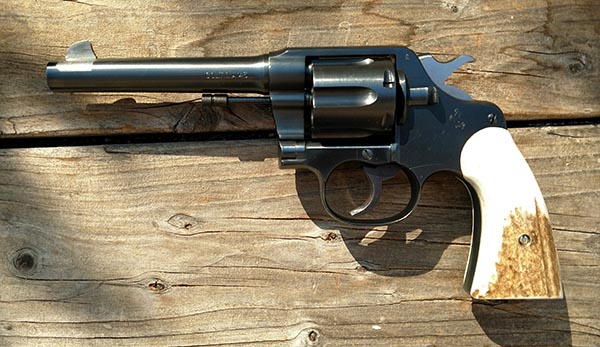
The 1917s are interesting handguns, and yeah, that’s plural. There were two of them: A Colt, and a Smith and Wesson. In a very real sense, they are handguns that were never meant to be. The 1911 Automatic came on the scene in 1911, and the plan was to ultimately incorporate it throughout our Armed Forces. But life is what happens when you’re making plans, and the US Government generally moves slowly. When we entered World War I in 1917, there weren’t enough 1911s to go around, so the US Army turned on Smith and Colt to make their large frame revolvers in .45 ACP, and that’s how the 1917s came to be. It was an emergency measure to make up for what we didn’t have yet, and that was enough 1911s to go around.
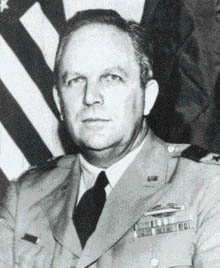
When World War II happened, the US military had plenty of 1911s, but there was at least one soldier who preferred the 1917. Interestingly, I recently read an account in American Rifleman magazine (yeah, I’m a strong NRA supporter and I watch Fox News, too) about 34-year-old Lieutenant Colonel James E. Rudder, who led the U.S. Army Rangers when they scaled the cliffs at Pointe du Hoc in Normandy on D-Day. Colonel Rudder carried a 1917 Colt instead of a 1911 auto (presumably, a 1917 that had been through the arsenal refurb and wore a Parkerized finish). Rudder was an interesting man. He held numerous awards for valor, he retired from the Army as a Major General, and he then went on to become president of Texas A&M University. The American Rifleman article was about Rudder’s 1917 Colt, which he preferred to the 1911 auto because of its greater reliability. Ah, if these guns could talk…
Help us keep the lights on…please click on the popup ads!
In the 1970s, when I was in the US Army stationed at Fort Bliss, Texas, I bought a 1917 Colt revolver at the El Paso gun show. I didn’t know too much about these guns then, except that they were large frame revolvers and they didn’t cost too much. I think I paid something like $125 for mine. It was cool. Big, heavy, Parkerized, and it shot the .45 ACP cartridge, a round I had already recognized as the ultimate handgun chambering. I had a .45 auto (a Government Model 1911), and having a revolver chambered for the same round felt like it was the right thing to do. My 1917 had interesting markings…it said US Army, United States Property, and all kinds of cool stuff. I liked it. I shot that revolver for a while, I had fun with it, and then I sold it to someone who wanted it more than I did. I think I got $200 for it, and in those days I fancied myself a Texas wheeler dealer gun guy.
But that 1917 danced around in my head for decades. I liked it and I missed it, and I wished I had kept it. Finally, a few years ago I started hunting for a replacement. The problem is, living here in the Peoples Republik of Kalifornia, I couldn’t look outside the left-leaning anti-gun liberal looney bin we call home, as the Model 1917 isn’t on our roster of handguns approved for sale here. If I was to find one, it would have to be one already here in LeftyLand, and that cut my options considerably. I kept an eye on the local gun shops (it’s okay if the gun is already in California, but the way the law is written I couldn’t bring in a 1917 from out of state). I checked Gunbroker.com (the premier site for gun sales) every few weeks. And I watched a California-specific site, Calguns.net. I kept looking, but none of the 1917s I saw looked nice enough for my tastes, or they were out ot state, or they were priced in the stratosphere.
Then I hit paydirt. Big time. I saw the 1917 you see in the photo above in a post on the Calguns.net site a couple of weeks ago. It looked to me like it had been reblued (because my earlier 1917 had been Parkerized and I’d never seen one that wasn’t) and the genuine stag grips were appealing (the 1917s originally wore uncheckered walnut grips). Those genuine stag grips all by themselves are a big ticket item and to me they look like they belong on a 1917. Unoriginal, yeah, but they sure looked good. The reblue (I thought) and the elk grips took away from the gun’s authenticity, but I liked the look. In fact, I liked it a lot.
I sent a message to the advertiser (who became my new good buddy Jim), and I learned that the gun had not been reblued. It wore its original brushed blue finish, and the direction of the brushing was an indication of its originality. The 1917s went through an arsenal refinish between the wars, Jim explained, and that’s when they were Parkerized. The original finish is the one you see in the photos here. I researched what Jim told me, and yup, he had it right. That made the gun even more appealing. (That brushed blue original finish and the brushing direction is what made the area on either side of the front sight look unblued when the camera’s flash hit it, but it is, in fact, blued). This particular 1917 is unfired other than proof rounds at the Colt factory, and this particular handgun was manufactured in Hartford, Connecticut, in 1918. Yep, it is 101 years old. And it’s essentially a new gun.
All right, I decided, I’d most likely never get an opportunity like this again. Jim and I met at Imbert and Smithers in Redwood City to legally transfer ownership, and I was blown away when I saw the revolver in person. It is stunning. The guy behind the counter, a dude about my age, was similarly impressed. “I’ve never seen one in this condition,” he said, and he called the gunsmith over to look at it. I’ll admit it: I like having a gun that’s the center of attention in a circle of folks who know guns. It’s a cool feeling.
Okay, enough bragging with words. Let me do so with a few photos I shot yesterday at the start of my 10-day cooling off period…

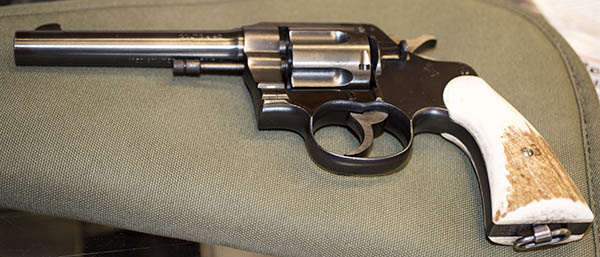

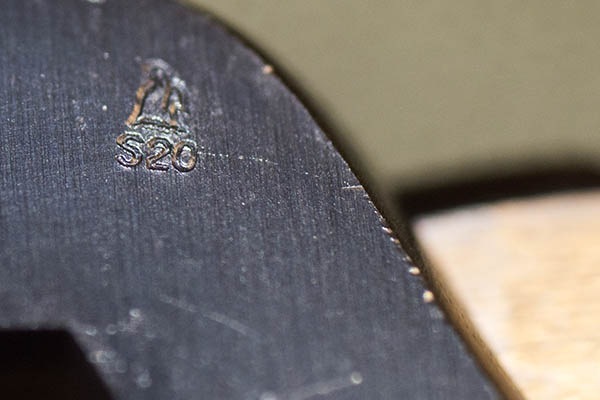
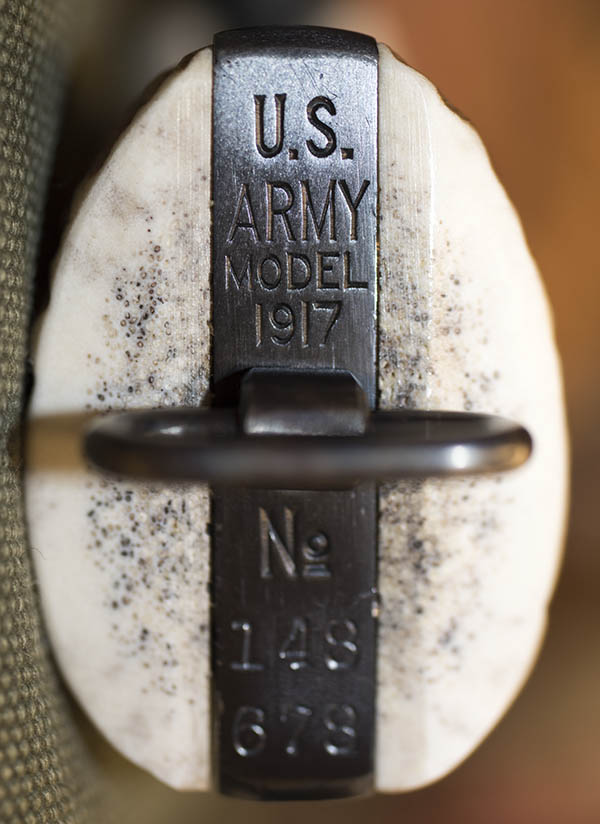
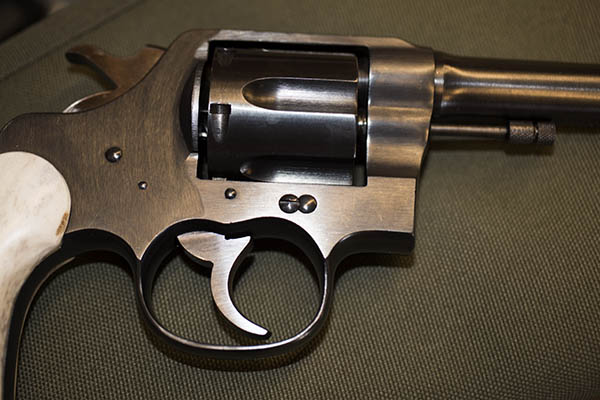
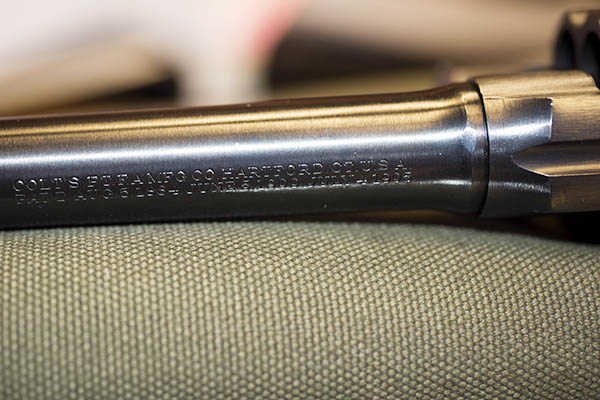
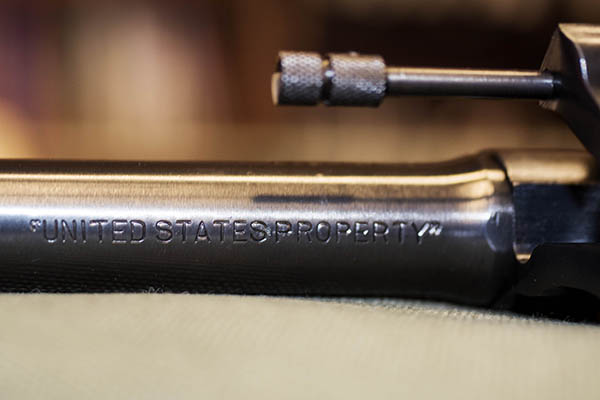
You might be wondering: Am I actually going to shoot this revolver?
You bet. And you’ll read about it here when I do. Just 9 more days, and I’ll be fully cooled off. And then this puppy is mine.
Read more Tales of the Gun, right here!
Never miss an ExNotes blog! Sign up here for free!


Quite a score!
Indeed. Very pleased with this one.
Very nice. I love the grips. Glad you found it. I was unaware there were .45 ACP revolvers. Way cool.
One extremely sweet firearm, Joe. Congratulations on the perseverance to find it…
Dad had one. As he was dying with lung cancer in 1959, Mom caught h holding it in bed, contemplating suicide. When he passed, she gave it to his brother, Joe. When Joe died of a heart attack in ’66, his wife gave it to my older brother. Bro said Joe had shot crappy ammo through it and not cleaned it, ruining the bore. I was in the Army and he sold it, so I never got a chance to fire it. Oh well, I’m a 9mm fan anyway.
As a side note, what do you think the security guys were packing at the Trump-Kim DMZ meetup today. Just curious.
Beats me, Bob. Probably something in 9mm or .45 ACP.
That is a beautiful firearm Joe! I love the history of it and especially the lanyard ring. Have fun. BTW to answer Bob’s question, the USSS carries the SIG Sauer P229 chambered in .357 SIG. I don’t know why they like that caliber but that is what they carry for their sidearm.
See you soon!
Thanks for that, Mike. My gunsmith told me the SIG and the .357 SIG chambering were the best combo in the world, and he’s done a number of custom guns for US Government LEOs. I guess your input is another validation of that. I fired Python Pete’s SIG in 9mm and I liked the handgun.
Joe,
Don’t you love it when you actually get a better deal than you originally bargained for. That is a beautiful gun, and it’s a revolver; the way guns are meant to be.
I do indeed.
Wow, that’s a beautiful piece, the score of a lifetime, I’d say!
My US Model 1917 Colt was Parkerized post-WWI, and my US Model 1917 S&W came with its original 1917 dated butt-forward right-hand leather holster. The revolver had apparently been in the holster so long, and stored with heavy unknown objects on top of it, that the holster had assumed the form and shape of the revolver, making it difficult to withdraw it from the holster. Plus, there are blotched areas in what’s left of the original bluing on both sides of the frame, consistent with finger placement. I once saw the same sort of blotches on an Ortgies .25 auto that belonged to a WWII vet who said he had taken it from the hands of a dead German officer in Italy. He said he cleaned the bloody fingerprints off of it some time later, but the blood had already done its damage to the blued finish. Boy oh boy, if old guns could only talk and tell us their stories!
Thanks much, Greg. Sounds like you and I have similar preferences in firearms. From my hunting experiences, I know it doesn’t take much for blood to mar a blued finish (it does so almost instantly).
You got that right. I learned many years ago to carry some paper towels and water to clean my hands off after gutting out game before handling my guns. Now I carry wet wipes and a plastic trash bag for them instead, as they take a lot less space in my day pack and are lighter.